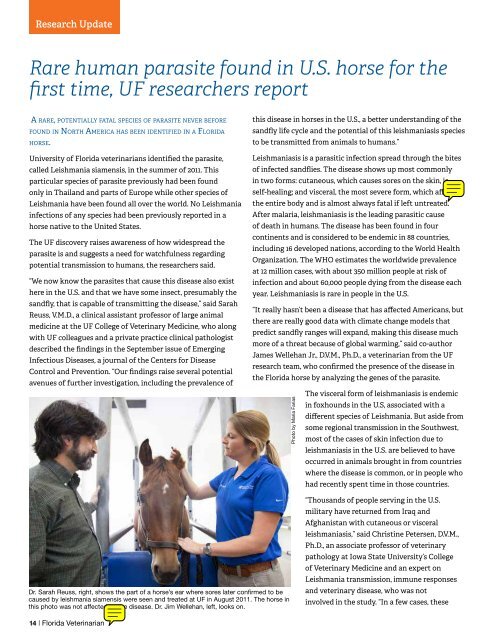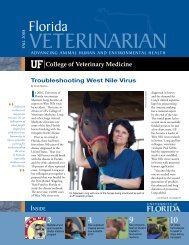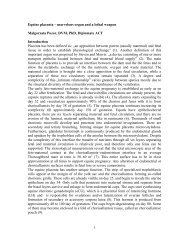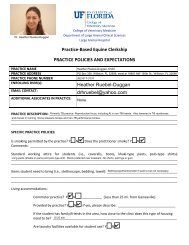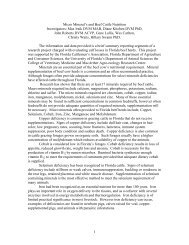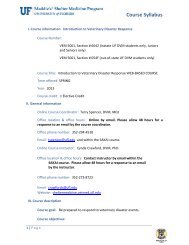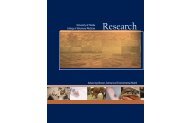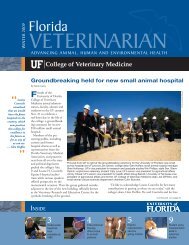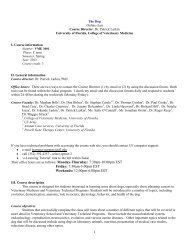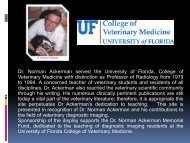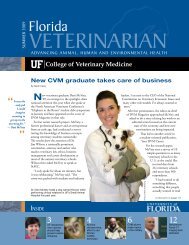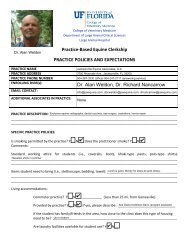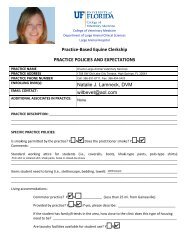Veterinarian - University of Florida College of Veterinary Medicine
Veterinarian - University of Florida College of Veterinary Medicine
Veterinarian - University of Florida College of Veterinary Medicine
- No tags were found...
Create successful ePaper yourself
Turn your PDF publications into a flip-book with our unique Google optimized e-Paper software.
Research UpdateRare human parasite found in U.S. horse for thefirst time, UF researchers reportA rare, potentially fatal species <strong>of</strong> parasite never beforefound in North America has been identified in a <strong>Florida</strong>horse.<strong>University</strong> <strong>of</strong> <strong>Florida</strong> veterinarians identified the parasite,called Leishmania siamensis, in the summer <strong>of</strong> 2011. Thisparticular species <strong>of</strong> parasite previously had been foundonly in Thailand and parts <strong>of</strong> Europe while other species <strong>of</strong>Leishmania have been found all over the world. No Leishmaniainfections <strong>of</strong> any species had been previously reported in ahorse native to the United States.The UF discovery raises awareness <strong>of</strong> how widespread theparasite is and suggests a need for watchfulness regardingpotential transmission to humans, the researchers said.“We now know the parasites that cause this disease also existhere in the U.S. and that we have some insect, presumably thesandfly, that is capable <strong>of</strong> transmitting the disease,” said SarahReuss, V.M.D., a clinical assistant pr<strong>of</strong>essor <strong>of</strong> large animalmedicine at the UF <strong>College</strong> <strong>of</strong> <strong>Veterinary</strong> <strong>Medicine</strong>, who alongwith UF colleagues and a private practice clinical pathologistdescribed the findings in the September issue <strong>of</strong> EmergingInfectious Diseases, a journal <strong>of</strong> the Centers for DiseaseControl and Prevention. “Our findings raise several potentialavenues <strong>of</strong> further investigation, including the prevalence <strong>of</strong>this disease in horses in the U.S., a better understanding <strong>of</strong> thesandfly life cycle and the potential <strong>of</strong> this leishmaniasis speciesto be transmitted from animals to humans.”Leishmaniasis is a parasitic infection spread through the bites<strong>of</strong> infected sandflies. The disease shows up most commonlyin two forms: cutaneous, which causes sores on the skin, isself-healing; and visceral, the most severe form, which affectsthe entire body and is almost always fatal if left untreated.After malaria, leishmaniasis is the leading parasitic cause<strong>of</strong> death in humans. The disease has been found in fourcontinents and is considered to be endemic in 88 countries,including 16 developed nations, according to the World HealthOrganization. The WHO estimates the worldwide prevalenceat 12 million cases, with about 350 million people at risk <strong>of</strong>infection and about 60,000 people dying from the disease eachyear. Leishmaniasis is rare in people in the U.S.“It really hasn’t been a disease that has affected Americans, butthere are really good data with climate change models thatpredict sandfly ranges will expand, making this disease muchmore <strong>of</strong> a threat because <strong>of</strong> global warming,” said co-authorJames Wellehan Jr., D.V.M., Ph.D., a veterinarian from the UFresearch team, who confirmed the presence <strong>of</strong> the disease inthe <strong>Florida</strong> horse by analyzing the genes <strong>of</strong> the parasite.Photo by Maria FariasThe visceral form <strong>of</strong> leishmaniasis is endemicin foxhounds in the U.S, associated with adifferent species <strong>of</strong> Leishmania. But aside fromsome regional transmission in the Southwest,most <strong>of</strong> the cases <strong>of</strong> skin infection due toleishmaniasis in the U.S. are believed to haveoccurred in animals brought in from countrieswhere the disease is common, or in people whohad recently spent time in those countries.Dr. Sarah Reuss, right, shows the part <strong>of</strong> a horse’s ear where sores later confirmed to becaused by leishmania siamensis were seen and treated at UF in August 2011. The horse inthis photo was not affected by the disease. Dr. Jim Wellehan, left, looks on.“Thousands <strong>of</strong> people serving in the U.S.military have returned from Iraq andAfghanistan with cutaneous or visceralleishmaniasis,” said Christine Petersen, D.V.M.,Ph.D., an associate pr<strong>of</strong>essor <strong>of</strong> veterinarypathology at Iowa State <strong>University</strong>’s <strong>College</strong><strong>of</strong> <strong>Veterinary</strong> <strong>Medicine</strong> and an expert onLeishmania transmission, immune responsesand veterinary disease, who was notinvolved in the study. “In a few cases, these14 | <strong>Florida</strong> <strong>Veterinarian</strong>


